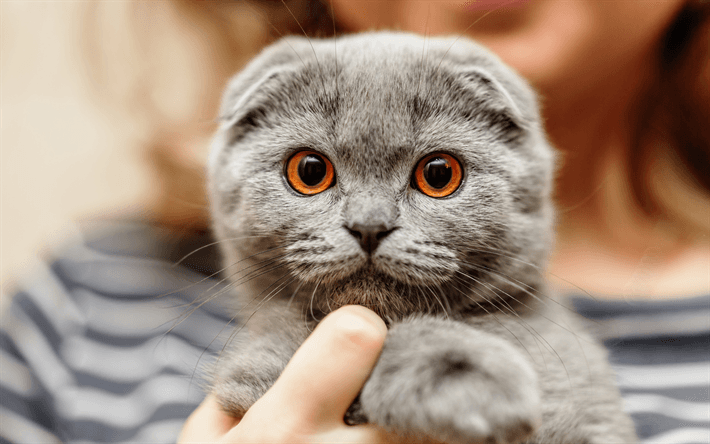Looks. Smarts. Health. We inherit a whole lot from our parents (and their DNA). The world of science is continually untangling the role that DNA has in making you – you. And Basepaws is working on this same special treatment for your favorite furriend too! Dear hooman, here are some of the most interesting facts about cat DNA.
1. Cats and humans share 90% of their DNA
Do you know how genetically close your feline is it to you? You may have thought that dogs would be a little closer to humans on the evolutionary scale, but it turns out that cats actually have 90.2% of the DNA in common with us! You read that right! Cats are genetically surprisingly closer to us than dogs, who share about 84% of the genes with us (Pontius et al, 2007). You and your furry friend share a lot of the same sequences that help you eat, sleep and chase laser pointers.
2. Your cat is descended from the African wildcat
Although there is evidence that cats were domesticated more than once, all living domestic cats are believed to share the same common ancestor - the African wildcat (lat. Felis silvestris lybica) (Vigne et al, 2016 & Wade, 2007). The theory of cat evolution suggests that these wildcats were first adopted around 10,000 years ago in the Middle East, when early farmers began to appreciate the ability of wildcats to torture and destroy pesky rodents.
Your cat may be more interested in a can of tuna than a mouse intruder, but most of the "killer instinct" genes are still in place and ready to be unleashed when needed.

Facts about Cat DNA
3. Most cat breeds are less than 100 years old
While the domestication of cats started approximately 9,000 - 10,000 years ago (Lipinski et al, 2008), people have only been selectively breeding cats for particular traits for less than 200 years. As it turns out that most cat breeds are less than 100 years old – far from ancient royalty. For example, the Sphynx breed first appeared in the 1960’s and came about completely accidentally. The distinctive hairless trait characteristic for the breed is a results of a recessive mutation in a single keratin gene KRT71 (Gandolfi et al, 2010).
4. Many cat diseases are hereditary
Just like humans, cats can inherit genes from their parents that make them more likely to suffer from diseases. Next to humans, the largest number of naturally occurring hereditary disorders and genetic predispositions to disease has been reported in dogs, followed by cats (Slutsky et al, 2013). Some diseases, like polycycstic kidney disease, are linked to a mutation in a single gene. Other diseases, like lower urinary tract diseases, are more complex and influenced by a number of different factors. Basepaws is actively searching for the genes that contribute to these diseases and more.
5. Many genes are involved in creating the unique appearance of your cat's coat
Cats come in a highly diverse variety of coat patterns, colorations and textures. Many different genes are involved in creating just how unique your feline companion will turn out to be. If you are interested in a narrow glimpse into the role of genetics in the cat's coat then dig into our peculiar articles about Cat coat genetics.
6. The Chimera cats are genetic miracles

Facts about Cat DNA: Chimera cat
Chimeras, as we know them here at Basepaws, are gorgeous and breathtaking genetic anomalies. They are composed of parent cells with different genotypes which most commonly occurs by the merger of multiple fertilized eggs. Due to the presence of two distinct genotypes, both expressing themselves in the phenotype, chimera cats are characterized with a mixture of tissues derived from different genomes. Therefore, they are their own identical twins. Isn’t that wild?!
7. Heterochromia is surprisingly common in cats
If your beautiful feline has two different eyes - a yellow and a blue, perhaps, then you’ve got yourself an odd-eyed kitten! These captivating little creatures are carriers of a feline form of a condition known as complete heterochromia. This is most commonly seen among white-colored felines, but may appear in all other cats who carry the white spotting gene too. You can find out more about the fascinating genetics and mechanism of feline eyes and heterochromia here.

Facts about Cat DNA: Heterochromia
Would you like to learn more about your cat's DNA? The Basepaws CatKit is the key to unraveling many more of your cat's secrets. And don't forget to keep an eye on our blog for many more curious pieces about our purrfect companions. Meow!
Sources and further reading:
1. Gandolfi B, Outerbridge CA, Beresford LG, Myers JA, Pimentel M, Alhaddad H, Grahn JC, Grahn RA, Lyions LA. (2010). The naked truth: Sphynx and Devon Rex cat breed mutations in KRT71. Mammalian genome. 21(9-19):509-515
2. Lipinski MJ, Froenicke L, Baysac JCm Billings NC, Leutenegger CM, Levy AM, Longeri M, Niini T, Ozpinar H, Slater MR, Pedersen NC, Lyons LA. (2007) The Ascent of Cat Breeds: Genetic Evaluations of Breeds and Worldwide Random Bred Populations. Genomics 91(1):12-21
3. Pontius JU, Mullikin JC, Smith DR, et al. (2007) Initial sequence and comparative analysis of the cat genome. _Genome Res._17: 1675-1689
4. Slutsky J, Karthik R, Yuhnke S, Bell J, Fretwell N, Hedhammar A, Wade C, Giger U (2013). A web resource on DNA tests for canine and feline hereditary diseases. Vet J. 197(2):182-187
5. Vigne JD, Evin A, Cuchi T, Dai L, Yu C et al. (2016) Earliest "Domestic" Cats in China Identified as Leopard Cat (Prionailurus bengalensis). PLOSone doi: https://doi.org/10.1371/journal.pone.0147295
6. Wade, Nicholas (2007). "Study Traces Cat's Ancestry to Middle East". The New York Times. Archived from the original on 18 April 2009.



